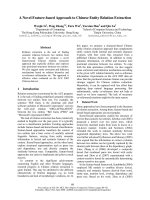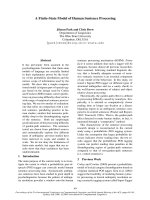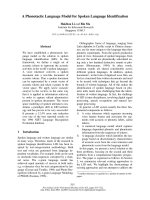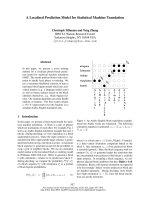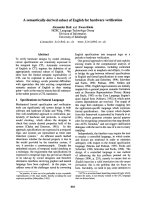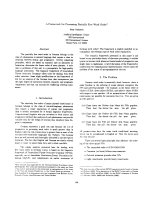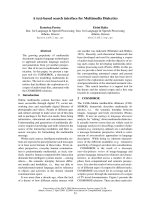Báo cáo khoa học: "A THREE-VALUED FEATURE INTERPRETATION OF NEGATION STRUCTURE DESCRIPTIONS" ppt
Bạn đang xem bản rút gọn của tài liệu. Xem và tải ngay bản đầy đủ của tài liệu tại đây (496.12 KB, 7 trang )
A THREE-VALUED INTERPRETATION OF NEGATION IN
FEATURE STRUCTURE DESCRIPTIONS
Anuj Dawar
Dept. of Comp. and Info. Science
University of Pennsylvania
Philadelphia, PA 19104
K. Vijay-Shanker
Dept. of Comp. and Info. Science
University of Delaware
Newark, DE 19718
April 20, 1989
ABSTRACT
Feature structures are informational elements that have
been used in several linguistic theories and in computa-
tional systems for natural-language processing. A logi-
caJ calculus has been developed and used as a description
language for feature structures. In the present work, a
framework in three-valued logic is suggested for defining
the semantics of a feature structure description language,
allowing for a more complete set of logical operators. In
particular, the semantics of the negation and implication
operators are examined. Various proposed interpretations
of negation and implication are compared within the sug-
gested framework. One particular interpretation of the
description language with a negation operator is described
and its computational aspects studied.
1 Introduction and Background
A number of linguistic theories and computational ap-
proaches to parsing natural language have employed the
notion of associating informational dements, called feature
structures, consisting of features and their values, with
phrases. Rounds and Kasper [KR86, RK86] developed a
logical calculus that serves as a description language for
these structures.
Several researchers have expressed a need for extending
this logic to include the operators of negation and impli-
cation. Various interpretations have been suggested that
define a semantics for these operators (see Section 1.2), but
none has gained universal acceptance. In [Per87], Pereira
set forth certain properties that any such interpretation
should satisfy.
In this paper we present an extended logical calculus,
with a semantics in three-valued logic (based on Kleene's
three-valued logic [Kh52]), that includes an interpretation
of negation motivated by the approach given by Kart-
tunen [Kar84]. We show that our logic meets the condi-
tions stated by Pereira. We also show that the three-valued
framework is powerful enough to express most of the pro-
posed definitions of negation and implication. It therefore
makes it possible to compare these different approaches.
1.1
Rounds-Kasper Logic
In [Kas87] and [RK86], Rounds and Kasper introduced a
logical formalism to describe feature structures with dis-
junctive specification. The language is a form of modal
propositional logic (with modal operator ":').
In order to define the semantics of this language, fea-
ture structures are formally defined in terms of acyelic
finite automata. These are finite-state automata whose
transition graphs are acyclic. The formal definition may
be found in
[RK86].
A fundamental property of the semantics is that the set
of automata satisfying a given formula is upward-closed
under the operation of subsumption. This is important,
because we consider a formula to be only a partial descrip-
tion of a feature structure. The property is stated in the
following theorem IRK86]:
Theorem 1.1 A C 8 if and only i/for every formula, ~,
if A ~ ~ then B ~ cb.
1.2 The Problem of Adding Negation
Several researchers in the area have suggested that the
logic described above should be extended to include nega-
tion and implication.
Karttunen [Kar84] provides examples of feature struc-
tures where a negation operator might be useful. For in-
stance, the most natural way to represent the number and
person attributes of a verb such as sleep would be to say
18
that it is
not
third person singular rather than expressing
it as a disjunction of the other tive possibilities. Kaxttunen
also suggests an implementation technique to handle neg-
ative information.
Johnson [Joh87], defined an Attribute Value Logic
(AVL), similar to the Rounds-Kasper Logic, that included
a classical form of negation. Kasper [Kas88] discusses an
interpretation of negation and implication in an implemen-
tation of Functional Unification Grammar [Kay79] that in-
cludes conditionals. Kasper's semantics is classical, but
his unification procedure uses notions similar to those of
three-valued logic a .
One aspect of the classical approach is that the prop-
erty of upward-closure under subsumption is lost. Thus
the evaluation of negation may not be freely interleaved
with unification 2
In [Kas88], Kasper localized the effects of negation
by disallowing path expressions within the scope of a
negation. This restriction may not be linguistically war-
ranted as can be seen by the following example from
Pereira [Per87] which expresses the semantic constraint
that the subject and object of a clause cannot be coref-
erential unless the object is a reflexive pronoun:
oh3 : type : reflezive V -~(subj : ref ~ obj : re f)
Moshier and Rounds [MR87] proposed an intuitionistic
interpretation of negation that preserves upward-closure.
They replace the notion of
saris/action
with one of model-
theoretic/arcing
an
described in Fitting [Fit69]. They also
provide a complete proof system for their logic. The satis-
liability problem for this logic was shown to be PSPACE-
complete.
1.3 Outline of this Paper
In the following section we will present our proposed solu-
tion in a three-valued framework, for defining the seman-
tics of feature structure descriptions including negation 3.
This solution is a formalization of the notion of negation
in Karttunen [Kar84]. In Section 3 we will show that
the framework of three-valued logic is flexible enough to
express most of the different interpretations of negation
mentioned above. In Section 4 we will show that the satis-
fiability problem for the logic we propose is NP-complete.
lsee Section 3.4
2see Pereira [Per87] p.1006
3 We shall concentrate only on the problem of extending the logic
to include the negation operator, and later in Section 3.4 discuss
Implication.
2 Feature Structure Descriptions with
Negation
We will now present our extended version of the Rounds-
Kasper logic including negation. We do this by giving
the semantics of the logic in a three-valued setting. This
provides an interpretation of negation that is intuitively
appealing, formally simple and computationally no harder
than the original Rounds-Kasper logic.
With each formula we associate the set (Tset) of au-
tomata that
satis/y
the formula, a set
(Fset)
of automata
that
contradict
it and a set (Uset) of automata which nei-
ther satisfy nor contradict it 4. Different interpretations of
negation are obtained by varying definitions of what con-
stitutes "contradiction." In the semantics we will define,
we choose a definition in which contradiction is equivalent
to
essential incompatibility 5.
We will define the
Tset
and
the
Fset so
that they are upward-closed with respect to
subsumption for all formulae. Thus, we avoid the prob-
lems associated with the classical interpretation of nega-
tion. In our logic, negation is defined so that an automaton
,4 satisfies -,~b if and only if it contra£1icts ~.
2.1 The Syntax
The symbols in the descriptive language, other than the
connectives :, v, A,-, and ~ are taken from two primitive
domains:
Atoms (A},
and
Labels (L).
The set of well formed formulae (W), is given by:
NIL;
TOP; a; 1 : @; ~ A ~b; @ V ~b; "-~ and pl ~- P2, where a E A;
1E L; ~,~ E W and
Pa,P2 E L'.
2.2
The Semantics
Formally, the semantics is defined over the domain of par-
tial functions from acycLic finite automata ~ to boolean val-
ues.
Definition 2.1
An acyclic finite automaton is a 7-tuple
A =< Q, E,
r,
6, qo, F,
A
>,
where:
1. Q is a non-empty finite set (of states),
~. E is a countable set (the alphabet),
4A similar notion was used by Kasper [Kas88], who introduces
the notion of compatibility. We shall comps.re this approach with
ou~ in greeter detail in Section 3.4.
Sln general, a feature structure is incompatible with a formula i£
the
information it contains is inconsistent with that in the formula.
We will distinguish two kinds of incompatibility. A feature struc-
ture is
essentiall~/incompatible
with a formula if the information in
it contradicts the information in the formula. It is
trivially
incom-
patible with the formula if the inconsistency is due to an excess of
mformtstion within the formula itself.
Sin this paper we will not consider cyclic feature structures
19
3. r is a countable set (the output alphabet),
4. 6 : Q × E -" Q is a finite partial/unction (the tran-
sition function),
5. qo ~ Q (the initial state),
6. F C Q (the set of final states),
7.
A
:
F "-* r is
a total function (the output function),
8. the directed graph (Q, E) is acyclic, where pEq iff
.for some 1 6 Z, 6(p, l) = q,
9 for every q ~ Q, there exists a directed path from qo
to q in ( Q, E), and
10. for every q ~ F, 6(q, I) is not defined for any I.
A formula ~ over the set of labels L and the set of
atoms A is chaxacterized by a
partial
function:
~r, : {'41"4 =< Q, L, A, 6, q0, F, A >} "7"
{True, False}
~#,('4) is
True
iff "4 satisfies ~b. It is
False
if'4 contra-
dicts ~b r and is undefined otherwise. The formal definition
is given below.
Definition 2.2
For any formula ¢~, the partial func-
tion .~'¢ over the set of acyclic finite automata, "4
=<
Q, L, A, 6, qo, F, A >, is defined as follows:
1. if ~ =
NIL then
~('4) = True for all "4;
~. if ~ = TOP then
~(,4) = False for all .4;
3.
if O m a for some a ~ A then
~(.,4) = True
if .4 is atomic and
A(q0) =
a
:7:(.4) = False
if "4 is atomic and
A(qo) = b
for some b, b # a (see Note ~.)
~'~( "4 ) is undefined otherwise;
4. if @ f l : @t for some l ~ L and @x 6 W then
~r ~ ( "4 ) __ ~r ~, ( "4 / l ) if.Aft is defined.
(see Note 3.)
:F,('4) is undefined otherwise;
rand therefore it satisfies the formula "-4,
5. if ~ = ~a A ~2 for some ~bi , ~2 E W then
.~'+('4) = True
if~r+,('4) = True and jr('4)= True
y+('4)
=
False
if ~r~,('4) = False
or ~'~('4) -
False
~('4) is undefined otherwise ;
6.
7+('4)
7~('4)
Y+('4)
V ~b2 for some ~,,~2 6 W then
• .~ True
if.~'~, ('4) = True or 9r¢2('4) =
True
= False
if ~x('4 ) =
False
and
F~2('4 ) =
False
is undefined otherwise ;
7.
if ~b "~1 for some ~h E W then
:~('4) = True if Y:~, ('4) = False
~r,#('4) =
False if gr~x
('4) =
True
~('4) is undefined otherwise ;
8.
if¢= m
~+('4)
~( "4)
7+('4)
~ I~ for some pa,p2 E L" then
= True
if 6(qo,p,) and 6(qo,p2) are defined
and
6(q0, pl)
6(qo,p2)
= False
if "4/pa and "4/P2 are both defined
and are not unifiable
is undefined otherwise (see Note 4.).
Notes:
I. We have not included an implication operator in
the formal language, since we find that defining im-
pllcation in terms of negation and disjunction (i.e
~b =~ ~b ~ -~@ V ~b) yields a semantics for implica-
tion that corresponds exactly to our intuitive un-
derstanding of implication.
2. As one would expect, an atomic formula is satisfied
by the corresponding atomic feature structure. On
the other hand, only atomic feature structures are
defined as contradicting an atomic formula. Though
a complex feature structure is clearly incompatible
with an atomic formula we do not view it as being
essentially
incompatible with it. An interpretation
of negation that defines a complex feature structure
as contradicting a (and hence satisfying -,a) is also
possible. However, our definition is motivated by
the linguistic intention of the negation operator as
given by Karttunen [Kar84]. Thus, for instance, we
require that an automaton satisfying the formula
case : ".dative
have an atomic value for the case
feature.
3. In J. above, we state that: ~'~('4) = jr',
('4/1) if.Aft
is defined. When
"4/l
is defined, ~t
('4/I)
may still
20
4.
be
True, False
or undefined. In any of these cases,
~#(.A) ~I(.A/I) s. ~r~(.A) is not defined if
.All
is not defined. Not only is this condition required
to preserve upward-closure, it is also linguistically
motivated.
Here again, we could have said that a formula of the
form I : ~bz is contradicted by any atomic feature
structure, but we have chosen not to do so for the
reasons outlined in the previous note.
We have chosen to state that the set of automata
that are incompatible with the formula pz ~ p2 is
not
the set of automata for which
6(qo,pl) and 6(qo,p~)
axe defined and 8(q0,pz) ~ 6(q0,p2), since such an
automaton could subsume one in which
6(qo,px) =
6(q0,p~). Thus, we would lose the property of
upward-closure under subsumption. However, an
automaton, .4, in which 6(q0,pl) and 8(qo,p2) are
defined and .A/p1 is not unifiable 9 with
~4/p2
can-
not subsume one in which 6(q0,pa) = 6(q0,p2).
2.2.1 Upward-Closure
As has been stated before, the set of automata that satisfy
a given formula in the logic defined above is upward-closed
under subsumption. This property is formally stated be-
low.
Theorem 2.1
Given a formula ~b and two acyclie finite
automata .4 and IJ, if ~(.A) is defined and .4 C B then
y.(B)
~,
defined and ;%(B) = 7.(~4).
Proof:
The proof is by induction on the structure of the formula.
The details may be found in Dawar [Daw88].
2.3 Examples
We now take a look at the examples mentioned earlier and
see how they are interpreted in the logic just defined. The
first example expressed the
agreement
attribute of the verb
sleep
by the following formula:
agreement : "~(person : third A number : singular)
(1)
This formula is satisfied by any structure that has an
agree-
ment
feature which, in turn, either has a
person
feature
with a value other than
third
or a
number
feature with a
value other than
singular.
Thus, for instance, the following
two structures satisfy the given formula:
agreement: [person: second]
SEquality here is strong equality
(i.e.
if .g,x(A]l) is undefined
then so is .~',(.4).)
9Two automata are not unifiable if and only if they do not have
a least upper bound
[ [p r,on ] ]
agreement : number : plural
On the other hand, for a structure to contradict formula(1)
it must have an
agreement
feature defined for both
person
and
number
with values
third
and
singular
respectively. All
other automata would have an undefined truth value for
formula(1).
Turning to the other example mentioned earlier, the
formula:
obj : type : reflexive x/"~(subj : ref ~ obj : re f)
(2)
is satisfied by the first two of the following structures, but
is contradicted by the third (here co-index boxes are used
to indicate co-reference or path-equivalence).
[obj.
[type-reflexive
]]
[ obj: [ ref:[] ] ]
subj : [ ref :[] ]
j]
type : reflezive
subj: [ re1: [] ]
3 Comparison with Other Interpreta-
tions of Negation
As we have stated before, the semantics for negation de-
scribed in the previous section is motivated by the dis-
cussion of negation in Karttunen [Kar84], and that it is
closely related to the interpretation of Kssper [Kas88]. In
this section, we take a look at the interpretations of nega-
tion that have been suggested and how they may be related
to interpretations in a three-valued framework.
3.1 Classical Negation
By classical negation, we mean an interpretation in which
an automaton .4 satisfies a formula -~b if and only if it does
not satisfy ~b. This is, of course, a two-valued logic. Such
an interpretation is used by Johnson in his Attribute-Value
Language [Joh87]. We can express it in our framework by
making ~'~ a total function such that wherever 9re(A) was
undefined, it is now defined to be
False.
Returning to our earlier example, we can observe that
for formula(1) the structure
[ agreement: [
person: third] ]
has a truth value of
.false
in the classical semantics but
has an undefined truth value in the semantics we define.
This illustrates the problem of non-monotonicity in the
classical semantics since this structure does subsume one
that satisfies formula (1).
21
3.2 Intultionistic Logic
In [MR87], Moshier and Rounds describe an extension of
the Rounds-Kasper logic, including an implication opera-
tor and hence, by extension, negation. The semantics is
based on intnitionistic techniques. The notion of
satisfying
is replaced by one of
forcing.
Given a set of automata/C,
a formula ~b, and .A such that .4 ~ /C, .A forces in IC "~b
(,4
hn
-~b) if and only if for all B ~/C such that A ~ B, B
does not force ~b in/~. Thus, in order to find if a formula,
~b, is satisfiable, we have to find a set ]C and an automaton
~4 such that forces in IC ~.
Moshier and Rounds consider a version in which forcing
is always done with respect to the set of all automata,
i.e. IC*. This means that the set of feature structures
that satisfy ~b is the largest upward-closed set of feature
structures that do not satisfy @ (i.e. the set of feature
structures incompatible with ~b). We can capture this in
the three-valued framework described above by modifying
the definition of ~r¢ to make it False for all automata that
are incompatible (trivially or essentially) with ~b (we call
this new function ~r~). The definition of ~'~ differs from
that of ~r+ in the following cases:
•
~b=a
~r¢(A) = True
if A is atomic and A(q0) = a
~r~(A) = False otherwise
~'~(~t) =
True
if ~'~(.A) True
:~(A) =
False
if All is defined and
vs(wl/! ~_ B =~
~,,(B)
=
False)
~r~(.A) is
undefined otherwise.
~'~(Ft) =
True
if ~+,(.,4) = True and .~+~(.A) = True
:r~,(A) =
False
if VB(A E_
S =~
~r~t(B) # True or Y;2(B) # True)
~(A) is undefined otherwise ;
•
~=~v~2
7;(,4) = Tr.e
if ~,(.A) = True or ~r~a(A ) = True
~(A) = False
if ¥B(.A C B
~';,(B) # True and Jr;.(B) # True)
~r~(.4) is undefined otherwise ;
• ~ = Pl ~ P2
7;(,4) = True
if 8(qo, p,) and ~(qo, p2) are defined
and ~(qo,pl) = 6(qo,p2)
F~(A) = False
if A/p1 and .A/p2 are both defined
and are not unifiable or if .4 is atomic
~'~(.4) is undefined otherwise .
In the other cases, the definition of ~'~ parallels that
of
7+.
To illustrate the difference between ~'~ and 3r~, we
define the following (somewhat contrived) formula:
cb = (11 :avl2 : a) AI2 : b
We also define the automaton
,4 = [11 : b]
We can now observe that F~(A) is undefined but 3r~(A) =
False. To see how this arises, note that in either system,
the truth value of ,4 is undefined with respect to each of
the conjuncts of ¢i. This is so because ,4 can certainly be
extended to satisfy either one of the conjuncts, just as it
can be extended to contradict either one of them. But, for
~c'~#(.A) to be False, .4 must have a truth value of False
for one of the conjuncts and therefore .~'¢(.4) is undefined.
On the other hand, since .4 can never be extended to sat-
isfy both conjuncts of ~ simultaneously, it can never be
extended to satisfy ~b. Hence .4 is certainly incompatible
with ~, but because this incompatibility is a result of the
excess of information in the formula itself, we say that it
is only trivially incompatible with ~.
To see more clearly what is going on in the above ex-
ample, consider the formula -~b and apply distributivity
and DeMorgan's law (which is a valid equivalence in the
logic described in the previous section, but not in the in-
tuitionistic logic of this section) which gives us:
-,~b = (-'la : a A "./2 : a) V -~12 : b
We can now see why we do not wish .4 to satisfy -~b, which
would be the case if .~'~#(~4) were
False.
One justification given for the use of forcing sets other
than /C* is the interpretation of formulae such as -~h :
NIL.
It is argued that since h :
NIL
denotes all feature
structures that have a feature labeled h, -,h :
NIL
should
denote those structures that do not have such a feature.
However, the formula -~h :
NIL
is unsatisfiable both in
the interpretation given in the last section as well as in the
/C* version of intuitionistic logic. It is our opinion that the
use of negation to assert the non-existence of features is
an operation distinct from the use of negation to describe
values mad should be described by a distinct operator. The
present work attempts to deal only with the latter notion of
negation. The authors expect to present in a forthcomi~ag
paper a simple extension to the current semantics that will
deal with issues of existence of features.
22
3.3 Karttunen's Implementation of Negation
As mentioned earlier, our approach was motivated by
Karttunen's implementation as described in [Kax84]. In
the unification algorithm
given,
negative constraints
are
attached to feature structures or automata (which them-
selves do not have any negative values). When the feature
structure is extended to have enough information to deter-
mine whether it satisfies or falsifies I° the formula then the
constraints may be dropped. We feel that our definition
of the
Uset
elegantly captures the notion of associating
constraints with automata that do not have sufficient in-
formation to determine whether they satisfy or contradict
a given formula.
3.4 Kasper's Interpretation of Negation and
Conditionals
As mentioned earlier, Kasper ~Kas88] used the operations
of negation mad implication in extending Functional Unifi-
cation Grammar. Though the semantics defined for these
operators is a classical one, for the purposes of the algo.
rithm Kasper identified three chases of automata associ-
ated with any formula: those that
satisfy
it, those that are
incompatible with
it and those that are
merely compatible
with it. We can observe that these are closely related to
our
Tact, Fset
and
User
respectively. For instance, Kasper
states that an automaton .A satisfies a formula f : v if it
is defined for f with value v; it is incompatible with f : v
if it is defined for f with value z (z ~ v) and it is merely
compatible with f : v if it is not defined for f. In three-
valued logic, we incorporate these notions into the formal
semantics, thus providing a formal basis for the unification
procedure given by Kasper. Our logic also gives a more
uniform treatment to the negation operator since we have
removed the restriction that disallowed path equivalences
in the scope of a negation.
4 Computational Issues
In this section, we will discuss some computational as-
pects related to determining whether a formula is satisfi-
able or not. We will Show that the satisfiability problem is
NP-complete, which is not surprising considering that the
problem is NP-complete for the logic not involving nega-
tion (Rounds-Kasper logic).
The NP-hardness of this problem is trivially shown
if we observe that for any formula, ~b, without negation,
Tset(¢) is
exactly the set of automata that satisfy ~ ac-
cording to the definition of satisfaction given by Rounds
l°It is not clear whether falsification is equivalent to incomp~-
ibility or only essential incompatibility, but from the examples in-
volvin~ ease and agreement, we believe that only emJential incom-
patibihty is intended.
and Kasper [KR86, RK86] in their original logic. Since
the satisfiabllity problem in that logic is NP-complete, the
given problem is NP-haxd.
In order to see that the given problem is in NP, we
observe that a simple nondeterministic algorithm 11 can be
given that is linear in the length of the input formula ~b
and that returns a minimal automaton which satisfies ~b,
provided it is satisfiable. To see this, note that the size
(in terms of the number of states) of a minimal automa-
ton satisfying ~b is linear in the length of ¢ and verifying
whether a given automaton satisfies ~b is a problem linear
in the length of ~b and the size of the automaton. The
details of the algorithm can be found in Dawar [DawS8].
5 Conclusions
A logical formalism with a complete set of logical operators
has come to be accepted as a means of describing feature
structures. While the intended semantics of most of these
operators is well understood, the negation and implication
operators have raised some problems, leading to a vari-
ety of approaches in their interpretation. In the present
work, we have presented an interpretation that combines
the following advantages: it is formally simple as well as
uniform (it places no special restriction on the negation
operator); it is motivated by the linguistic applications of
feature structures; it takes into account the partial na-
ture of feature structures by preserving the property of
monotonicity under unification and it is computationally
no harder than the Rounds-Kasper logic. More signifi-
cantly, perhaps, we have shown that most existing inter-
pretations of negation can also be expressed within three-
valued logic. This framework therefore provides a means
for comparing and evaluating various interpretations.
References
[Daw88]
[Fit69]
Anuj Dawar.
The Semantics of Negation in Fea-
ture Structure Descriptions.
Master's thesis, Uni-
versity of Delaware, 1988.
Melvin Fitting.
Intuitionistic Logic and Model
Theoretic Forcing.
North-Holland, Amsterdam,
1969.
[Joh87]
Mark Johnson.
Attribute Value Logic and the
Theory of Grammar.
PhD thesis, Stanford Uni-
versity, August 1987.
[K~84]
Lauri Karttunen. Features and values. In
Pro.
ceedings of the Tenth International Conference on
Computational Linguistics,
July 1984.
llthis algorithm assumes that the se¢ of atoms is finite.
23
[Kas87] Robert T. Kasper.
Feature Structures: A Logical
Theory with Application to Language Analysis.
PhD thesis, University of Michigan, 1987.
[Kas88] Robert T. Kasper. Conditional descriptions in
Functional Unification Grammar. In
Proceedings
of the ~6th Annual Meeting o] the Association/or
Computational Linguistics,
pages 233-240, June
1988.
[Kay79] M. Kay. Functional grammax. In
Proceedings of
the Fifth Annual Meeting of the Berkeley Linguis-
tics Society,
1979.
[Kle52] S.C. Kleene.
Introduction to Metamathematics.
Van Nostrand, New York, 1952.
[KR86] Robert T. Ka~per and William C. Rounds. A
logical semantics for feature structures. In
Pro-
ceedings o/the ~th Annual Meeting o.( the Asso-
ciation for Computational Linguistics,
1986.
[MR87] M. Drew Moshier and William C. Rounds. A
logic for partially specified data structures. In
ACM Symposium on the Principles
o~
Program.
ruing Languages,
pages 156-167, ACM, 1987.
[Per87] Fernando C. N. Pereira. Grammars and logics
of partial information. In Jean-Louis Lassez, ed-
itor,
Proceedings o] the 4th International Con-
ference on Logic Programming,
pages 989-1013,
May 1987.
IRK86] William C. Rounds and Robert T. Kasper.
A complete logical calculus for record struc-
tures representing linguistic information. In
IEEE Symposium on Logic in Computer Science,
pages 34-43, IEEE Computer Society, June 1986.
24



